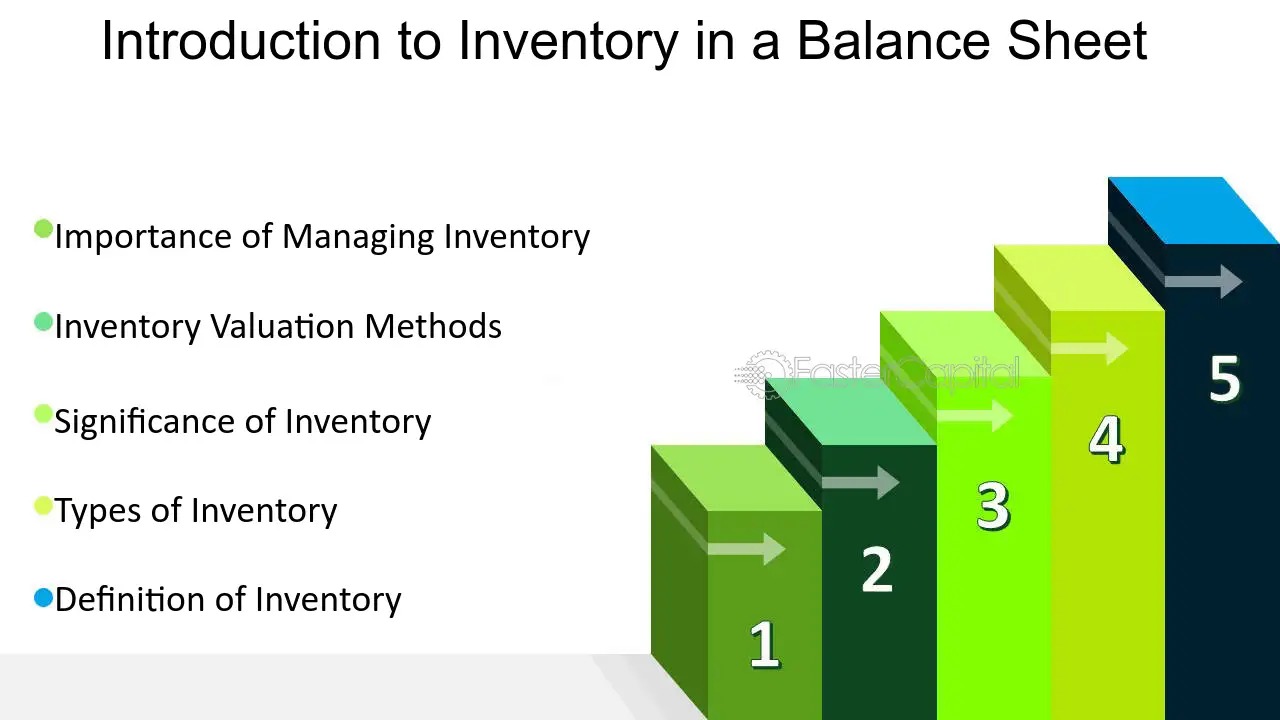Home>Finance>How Do Letters Of Credit Show Up On The Balance Sheet?


Finance
How Do Letters Of Credit Show Up On The Balance Sheet?
Modified: March 1, 2024
Learn how letters of credit are reflected on the balance sheet in the field of finance. Discover the impact of these financial instruments on business accounting.
(Many of the links in this article redirect to a specific reviewed product. Your purchase of these products through affiliate links helps to generate commission for LiveWell, at no extra cost. Learn more)
Table of Contents
Introduction
Welcome to the world of finance, where companies often engage in various transactions to facilitate their operations and grow their businesses. One important aspect of these transactions is the use of letters of credit. If you’ve ever wondered how letters of credit are represented on a company’s balance sheet, then you’re in the right place. In this article, we will explore the definition of letters of credit, their role in business transactions, and their accounting treatment that ultimately determines how they show up on the balance sheet.
Definition of Letters of Credit:
A letter of credit is a financial instrument used by businesses to guarantee payment to suppliers or vendors. It is essentially a promise to pay issued by a bank or financial institution on behalf of the buyer, known as the applicant. The letter of credit ensures that the seller, or the beneficiary, will receive payment for goods or services rendered, as long as they meet the specified terms and conditions outlined in the document.
Role of Letters of Credit:
Letters of credit play a crucial role in international trade, where trust can be a significant concern for both parties involved in a transaction. By utilizing a letter of credit, the buyer can provide assurance to the seller that payment will be made upon successful completion of the transaction. It also mitigates the risk associated with non-payment or default by the buyer.
The letter of credit is a widely accepted method of payment in international trade because it provides security to both parties. For the buyer, it ensures that the seller fulfills their contractual obligations before payment is made. On the other hand, the seller can be confident in receiving payment as long as they meet the terms and conditions specified in the letter of credit.
Accounting Treatment of Letters of Credit:
Now that we understand the purpose and role of letters of credit let’s dive into their accounting treatment. When a company opens a letter of credit, it incurs a contingent liability. A contingent liability is a potential obligation that may arise in the future, depending on the outcome of a specific event or circumstance. Since the outcome of the transaction is uncertain at the time of opening the letter of credit, it is classified as a contingent liability on the balance sheet.
However, not all letters of credit are guaranteed to result in a contingent liability. If the beneficiary fails to meet the terms and conditions specified in the letter of credit, no payment obligation arises for the applicant. In this case, the letter of credit is not recognized as a contingent liability on the balance sheet.
Definition of Letters of Credit:
In the world of international trade, letters of credit are a vital tool that helps facilitate secure and efficient transactions between buyers and sellers. A letter of credit is a financial instrument issued by a bank or financial institution on behalf of a buyer, known as the applicant, to guarantee payment to a seller, referred to as the beneficiary.
The purpose of a letter of credit is to provide assurance to the seller that they will receive payment for their goods or services once they fulfill the specified terms and conditions set forth in the document. This helps reduce the risk of non-payment or default by the buyer and builds trust between the two parties involved in the transaction.
When a buyer and seller engage in an international transaction, they may face challenges related to geographic distance, cultural differences, and unfamiliarity with each other’s business practices and reputations. These challenges can create a significant level of uncertainty and risk. However, by utilizing a letter of credit, these risks can be mitigated.
Here’s how a typical letter of credit transaction works:
- The buyer and seller agree to use a letter of credit as the method of payment for the transaction.
- The buyer approaches their bank, known as the issuing bank, and requests them to issue a letter of credit in favor of the seller.
- The issuing bank, after assessing the buyer’s creditworthiness, issues the letter of credit to the seller’s bank, known as the advising bank.
- The advising bank notifies the seller, providing them with details of the letter of credit, including the terms and conditions that must be met to receive payment.
- Once the goods or services are delivered by the seller as per the agreed-upon terms, they present the required documents to the advising bank.
- The advising bank verifies the documents and, if they comply with the letter of credit terms, forwards them to the issuing bank.
- The issuing bank, upon reviewing and confirming the compliance of the documents, makes the payment to the seller.
- The advising bank then notifies the seller, confirming the payment has been made.
- The buyer, in turn, reimburses their bank for the amount paid to the seller, as per the terms agreed in the letter of credit.
By following these steps, letters of credit provide a level of security and assurance to both the buyer and the seller. The buyer can be confident that the goods or services will be delivered as agreed before payment is made. At the same time, the seller can trust that they will receive payment as long as the terms and conditions specified in the letter of credit are met.
It’s important to note that letters of credit can be used in various types of transactions, including both domestic and international ones. They are particularly prevalent in industries such as manufacturing, construction, and international trade, where risks and uncertainties regarding payment and delivery are more pronounced.
Role of Letters of Credit:
Letters of credit play a crucial role in facilitating smooth and secure transactions, especially in the realm of international trade. They provide a level of trust and confidence between buyers and sellers by mitigating the risks associated with non-payment or default. Let’s explore the key roles that letters of credit play in business transactions:
- Payment Guarantee: One of the primary roles of letters of credit is to provide a guarantee of payment to the seller. By using a letter of credit, the buyer’s bank assumes the responsibility of making payment to the seller upon the successful completion of the transaction. This guarantee gives the seller the assurance that they will receive payment for their goods or services, thereby reducing the risk of financial loss.
- Risk Mitigation: Letters of credit help mitigate the risks associated with international trade. By utilizing a letter of credit, the buyer can ensure that the seller meets specific terms and conditions before payment is made. This reduces the risk of receiving substandard goods, counterfeit products, or fraudulent activities. It also protects the buyer from issues such as non-delivery or delivery of incorrect or damaged goods.
- Trade Facilitation: Letters of credit facilitate smooth transactions by providing a standardized method of payment and documentation. As a widely accepted payment instrument, letters of credit help streamline and expedite the exchange of goods and payment between parties involved in international trade. It provides a framework for the smooth flow of goods and services across borders, particularly in markets where trust and transparency may be limited.
- Trust Building: Letters of credit contribute to building trust between buyers and sellers in international transactions. It provides a level of assurance to both parties that their rights and interests are protected. Sellers trust that they will receive payment upon fulfilling the documented terms and conditions, while buyers gain confidence that their suppliers will deliver the goods or services as agreed.
- Financing Assistance: Letters of credit can also serve as a source of financing for businesses. In some cases, the seller may request that the letter of credit allows for partial or progressive payments against the presentation of pre-defined documents or milestones. This can provide the seller with much-needed working capital to fund their operations or production while waiting for the final payment to be made.
Overall, letters of credit are invaluable tools in international trade, providing security, trust, and efficient payment mechanisms. By mitigating risks and ensuring compliance with agreed-upon terms, they help build strong business relationships and contribute to the growth and success of companies engaged in global commerce.
Accounting Treatment of Letters of Credit:
When it comes to accounting for letters of credit, it is essential to understand their nature as contingent liabilities. A contingent liability is a potential obligation that may arise in the future, depending on the outcome of a specific event or circumstance. In the case of letters of credit, the contingent liability arises when the beneficiary fulfills the terms and conditions set forth in the document.
Let’s take a closer look at the accounting treatment of letters of credit:
Recognition: When a company opens a letter of credit, it does not initially recognize it as a liability on the balance sheet. Instead, it considers it as a contingent liability. This is because the actual payment obligation depends on the successful completion of the transaction by the seller. The contingent liability is disclosed in the financial statement footnotes as a potential obligation that may or may not materialize in the future.
Measurement: The measurement of contingent liabilities, including letters of credit, is typically based on the likelihood of the payment obligation arising. If it is considered probable that the beneficiary will fulfill the terms and conditions, then the contingent liability is measured at the best estimate of the amount to be paid. If the likelihood is uncertain or remote, no amount is recognized in the financial statements.
Subsequent Recognition: As the event or circumstance triggering the payment obligation occurs and the beneficiary fulfills the terms and conditions, the contingent liability transforms into an actual liability. At this point, the company recognizes the liability on the balance sheet and adjusts the corresponding amount in the financial statements.
Disclosures: Along with the initial disclosure of the contingent liability in the footnotes, companies are also required to provide additional information about the letters of credit in their financial statements. This includes details about the purpose, terms, and conditions of the letter of credit, as well as any significant contingencies or risks associated with it.
It’s important to note that not all letters of credit result in a contingent liability. If the beneficiary fails to fulfill the terms and conditions specified in the letter of credit, no payment obligation arises for the applicant. In this case, the letter of credit is not recognized as a contingent liability on the balance sheet.
Accounting for letters of credit requires careful assessment of the likelihood of the payment obligation, proper disclosure, and subsequent recognition when the obligation materializes. By adhering to these accounting principles, companies can accurately represent their financial position and provide transparency to stakeholders regarding their potential liabilities.
How Letters of Credit Show Up on the Balance Sheet:
Letters of credit play a significant role in international trade and financial transactions. When it comes to representing letters of credit on a company’s balance sheet, their treatment depends on the stage of the transaction and the outcome of the payment obligation. Let’s delve into how letters of credit show up on the balance sheet:
Contingent Liability: When a letter of credit is initially opened, it is classified as a contingent liability on the balance sheet. This is because the payment obligation depends on the fulfillment of the terms and conditions outlined in the document. The contingent liability is typically disclosed in the financial statement footnotes.
Disclosure of Contingent Liability: Alongside financial statement presentation, companies provide additional information about the contingent liability in the footnotes. This includes details about the purpose, terms, and conditions of the letter of credit, as well as any significant contingencies or risks associated with it. The disclosure ensures transparency and helps investors and stakeholders understand the nature and potential impact of the contingent liability.
Actual Liability recognition: When the beneficiary meets the terms and conditions outlined in the letter of credit, the contingent liability transforms into an actual liability. At this point, the company records the liability on the balance sheet, reflecting the payment obligation that has arisen. The amount recorded is based on the best estimate of the payment obligation, which is typically the amount specified in the letter of credit.
Classification of Liability: The actual liability arising from the letter of credit is classified under the appropriate category on the balance sheet. Depending on the nature of the transaction and the company’s accounting practices, it may be classified as a current liability if the payment obligation is expected to be settled within the next year or as a non-current liability if the settlement is beyond one year.
Subsequent Measurement: Once the liability is recognized on the balance sheet, it is measured at the amount to be paid. This amount represents the payment obligation resulting from the successful completion of the transaction by the beneficiary.
Impact on Financial Ratios: The recognition of the letter of credit liability can have implications for financial ratios. It can affect liquidity ratios, such as the current ratio, as it increases the amount of short-term liabilities. However, the specific impact depends on the magnitude of the liability and the overall financial position of the company.
It’s important to note that if the beneficiary fails to fulfill the terms and conditions specified in the letter of credit, no payment obligation arises for the applicant. In this case, the letter of credit is not recognized as a contingent liability or an actual liability on the balance sheet.
Proper representation of letters of credit on the balance sheet ensures transparency and accuracy in financial reporting. Companies must carefully assess the stage of the transaction, the likelihood of the payment obligation, and the subsequent recognition and measurement of the liability to provide an accurate snapshot of their financial position.
Implications for Financial Analysis:
The presence of letters of credit on a company’s balance sheet can have several implications for financial analysis. It is important for analysts and investors to consider these implications when evaluating a company’s financial health and performance. Let’s explore the key implications of letters of credit for financial analysis:
Risk Assessment: The existence of contingent liabilities, such as letters of credit, indicates the potential financial risks associated with the company’s business activities. Financial analysts should carefully assess the magnitude of these liabilities and analyze the terms and conditions of the letters of credit to evaluate the potential impact on the company’s financial position. Higher levels of contingent liabilities may indicate heightened business risks.
Liquidity Analysis: Letters of credit can affect a company’s liquidity position. The recognition of actual liabilities resulting from the successful completion of transactions can increase short-term liabilities, which, in turn, may impact liquidity ratios such as the current ratio. Analysts should consider the impact of the payment obligations arising from letters of credit on a company’s ability to meet its short-term obligations and manage cash flows effectively.
Business Relationships: The presence of letters of credit on a company’s balance sheet can provide insights into its relationships with suppliers and partners. The usage of letters of credit may indicate a reliance on international trade or complex business transactions. Financial analysts should evaluate the company’s ability to establish and maintain trusted relationships with suppliers and assess the potential impact of any issues related to the letters of credit on the company’s supply chain and operations.
Transaction Flow: Letters of credit can offer visibility into the company’s transaction flow and its engagement in international trade. Analysts can examine the frequency and value of letters of credit to gain insights into the scale and nature of the company’s business activities, including import-export activities. This information can be useful for assessing the company’s market reach, diversification strategies, and exposure to international market fluctuations.
Contingent Liabilities: Financial analysts should carefully analyze the disclosure and management of contingent liabilities associated with letters of credit. Understanding the terms and conditions, expiration dates, and potential risks of these contingent liabilities is crucial for accurately assessing a company’s financial position and forecasting potential future obligations. It is important to consider both the likelihood of the payment obligation arising and the potential impact it may have on the company’s financial stability.
While letters of credit can add complexity to financial analysis, understanding their implications allows analysts to make more informed decisions. It is crucial to consider these implications in conjunction with other financial and non-financial factors when evaluating a company’s overall performance and prospects for future growth.
Conclusion:
Letters of credit are essential financial instruments that provide security and facilitate transactions in the realm of international trade. Understanding how letters of credit are represented on a company’s balance sheet is crucial for accurate financial analysis and assessment of a company’s financial health.
Throughout this article, we have explored the definition of letters of credit, their role in transactions, and their accounting treatment. We have seen that letters of credit are initially recognized as contingent liabilities on the balance sheet, representing potential payment obligations that may arise in the future. Subsequent recognition occurs when the beneficiary fulfills the terms and conditions, turning the contingent liability into an actual liability.
Financial analysis of a company with letters of credit requires careful consideration of the contingent liabilities and their potential impact on the company’s financial position, liquidity, and risk profile. The presence of letters of credit can indicate the company’s involvement in international trade, provide insights into its business relationships and transaction flow, and contribute to evaluating its risk exposure.
Furthermore, understanding the disclosure and management of contingent liabilities associated with letters of credit is critical to accurately assessing a company’s financial stability and forecasting potential future obligations.
In conclusion, letters of credit play a vital role in international trade transactions, offering assurance to both buyers and sellers. Their representation on the balance sheet as contingent and actual liabilities provides valuable information for financial analysis. By considering the implications of letters of credit, analysts can gain insights into a company’s financial position, risk profile, liquidity, and business relationships.
As financial markets continue to become more globalized, letters of credit will remain a significant element of international trade and finance. Companies and analysts alike must stay knowledgeable about their accounting treatment and the implications they have on financial analysis in order to make well-informed decisions and assessments.














